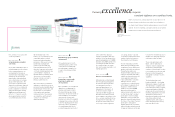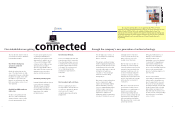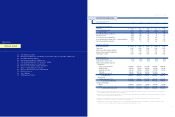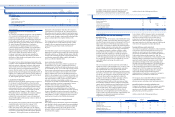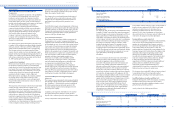Humana 1999 Annual Report Download - page 15
Download and view the complete annual report
Please find page 15 of the 1999 Humana annual report below. You can navigate through the pages in the report by either clicking on the pages listed below, or by using the keyword search tool below to find specific information within the annual report.
19 9 8 EX P E NS E S
Market Exits, Non-Core Asset Sales and Merger
Dissolution Costs
On August 10, 1998, the Company and UnitedHealth Group
Company (“United”) announced their mutual agreement to
terminate the previously announced Agreement and Plan of
Merger, dated May 27, 1998. The planned merger, among
other things, was expected to improve the operating results
of the Company’s products and markets due to overlapping
markets with United. Following the merger’s termination,
the Company conducted a strategic evaluation, which
included assessing the Company’s competitive market
positions and profit potential. As a result, the Company
recognized expenses of $34 million during the third quarter
of 1998. The expenses included costs associated with exiting
five markets ($15 million), losses on disposals of non-core
assets ($12 million) and merger dissolution costs
($7 million).
The costs associated with the market exits of $15 million
included severance, lease termination costs as well as write-
offs of equipment and uncollectible provider receivables.
The planned market exits were Sarasota and Treasure
Coast, Florida, Springfield and Jefferson City, Missouri and
Puerto Rico. Severance costs were estimated based upon the
provisions of the Company’s employee benefit plans. The
plan to exit these markets was expected to reduce the
Company’s market office workforce, primarily in Puerto
Rico, by approximately 470 employees. In 1999, the
Company reversed $2 million of the severance and lease
discontinuance liabilities after the Company contractually
agreed with the Health Insurance Administration in Puerto
Rico to extend the Company’s Medicaid contract, with
more favorable terms. The Company estimated annual
pretax savings of approximately $40 million, after all
market exits were completed by June 30, 1999, primarily
from a reduction in underwriting losses. Approximately 100
employees were ultimately terminated resulting in
insignificant severance payments.
In accordance with the Company’s policy on impairment
of long-lived assets, equipment of $5 million in the exited
markets was written down to its fair value after an
evaluation of undiscounted cash flow in each of the
markets. The fair value of equipment was based upon
discounted cash flows for the same markets. Following the
write-down, the equipment was fully depreciated.
Premium Deficiency and Provider Costs
As a result of management’s assessment of the profitability
of its contracts for providing health care services to its
members in certain markets, the Company recorded a
provision for probable future losses (premium deficiency)
of $46 million during the third quarter of 1998. The
premium deficiency resulted from events prompted by the
terminated merger with United wherein the Company had
expected to realize improved operating results in those
markets that overlapped with United, including more
favorable risk-sharing arrangements. The beneficial effect
from losses charged to the premium deficiency liability
in 1999 and 1998 was $23 million and $17 million,
respectively. In 1999, the Company reversed $6 million
of premium deficiency liabilities after the Company
contractually agreed with the Health Insurance
Administration in Puerto Rico to extend the Company’s
Medicaid contract, with more favorable terms.
The Company also recorded $27 million of expense related
to receivables written-off from financially troubled
physician groups, including certain bankrupt providers.
Non-Officer Employee Incentive and Other Costs
During the third quarter of 1998, the Company recorded a
one-time incentive of $16 million paid to non-officer
employees and a $9 million settlement related to a third
party pharmacy processing contract.
Activity related to the 1998 expenses follows:
27
19 9 9 EX P E NS E S
Premium Deficiency, Reserve Strengthening and
Provider Costs
As a result of management’s assessment of the profitability
of its contracts for providing health care services to its
members in certain markets, the Company recorded a
provision for probable future losses (premium deficiency)
of $50 million during the first quarter of 1999. Ineffective
provider risk-sharing contracts and the impact of the March
31, 1999 Columbia/HCAHealthcare Corporation
(“Columbia/HCA”) hospital agreement in Florida on
current and projected future medical costs contributed to
the premium deficiency. The beneficial effect from losses
charged to the premium deficiency liability throughout
1999 was $50 million. Because the majority of the
Company’s customers’ contracts renew annually, the
Company does not anticipate the need for a premium
deficiency in 2000, absent unanticipated adverse events or
changes in circumstances.
Prior period adverse claims development primarily in the
Company’s PPO and Medicare products initially identified
during an analysis of February and March 1999 medical
claims resulted in the $35 million reserve strengthening.
The Company releases or strengthens medical claims
reserves when favorable or adverse development in prior
periods exceed actuarial margins existing in the reserves. In
addition, the Company paid Columbia/HCA$5 million to
settle certain contractual issues associated with the March
31, 1999 hospital agreement in Florida.
Long-Lived Asset Impairment
Historical and current period operating losses in certain of
the Company’s markets prompted a review during the
fourth quarter of 1999 for the possible impairment of long-
lived assets. This review indicated that estimated future
undiscounted cash flows were insufficient to recover the
carrying value of long-lived assets, primarily goodwill,
associated with the Company’s Austin, Dallas and
Milwaukee markets. Accordingly, the Company adjusted
the carrying value of these long-lived assets to their
estimated fair value resulting in a non-cash impairment
charge of $342 million. Estimated fair value was based on
discounted cash flows.
The long-lived assets associated with the Austin and Dallas
markets primarily result from the Company’s 1997
acquisition of PCA. Operating losses in Austin and
Dallas were related to the deterioration of risk-sharing
arrangements with providers and the failure to effectively
convert the PCAoperating model and computer platform
to Humana’s. The long-lived assets associated with the
Milwaukee market primarily result from the Company’s
1994 acquisition of CareNetwork, Inc. Operating losses in
Milwaukee were the result of competitor pricing strategies
resulting in lower premium levels to large employer groups
as well as market dynamics dominated by limited provider
groups causing higher than expected medical costs.
The Company also re-evaluated the amortization period
of its goodwill and as a result, effective January 1, 2000,
adopted a 20 year amortization period from the date of
acquisition for goodwill previously amortized over
40 years.
The $342 million long-lived asset impairment will decrease
depreciation and amortization expense $13 million annually
($13 million after tax, or $0.08 per diluted share), while the
change in the amortization period of goodwill will increase
amortization expense $25 million annually ($24 million
after tax, or $0.15 per diluted share).
Losses on Non-Core Asset Sales
The Company has entered into definitive agreements for
the disposition of its workers’ compensation, Medicare
supplement and North Florida Medicaid businesses, which
are considered non-core. As a result of the carrying value of
the net assets of these businesses exceeding the estimated
sale proceeds, the Company has recorded a loss of $118
million. Estimated fair value was established based upon
definitive sale agreements, net of expected transaction costs.
These transactions are expected to be completed in the first
and second quarters of 2000. Total assets of $725 million,
primarily consisting of marketable securities and
reinsurance recoverables and total liabilities of $490 million,
primarily consisting of worker’s compensation reserves
related to these businesses are included in the
accompanying Consolidated Balance Sheets. The
accompanying Consolidated Statements of Operations
include 1999 revenues of $214 million and pretax operating
income of $38 million from these businesses. Included in
1999 and 1998 pretax operating (loss) income is $36 million
and $5 million of workers’ compensation reserve releases
resulting from favorable claim liability development.
Professional Liability Reserve Strengthening and
Other Costs
The Company insures substantially all professional liability
risks through a wholly owned captive insurance subsidiary
(the “Subsidiary”). The Subsidiary recorded an additional
$25 million expense during the fourth quarter of 1999
primarily related to expected claim and legal costs to be
incurred by the Company.
26
Balance at
1999 1999 Activity December 31,
(In millions) Expenses Cash Non-Cash 1999
Premium deficiency $ 50 $ (50) —
Reserve strengthening 35 (35) —
Provider costs 5 (5) —
Long-lived asset impairment 342 $ (342) —
Losses on non-core asset sales 118 (28) $ 90
Professional liability reserve
strengthening and other costs 35 35
$ 585 $ (90) $ (370) $ 125
Balance at Balance at
1998 1998 Activity December 31, 1999 Activity December 31,
(In millions) Expenses Cash Non-cash 1998 Cash Adjustment 1999
Premium deficiency $ 46 $ (17) $ 29 $ (23) $ (6) $ —
Provider costs 27 $ (27) —
Market exit costs 15 (10) 5 (2) (2) 1
Losses from non-core asset sales 12 (5) (7) —
Merger dissolution costs 7 (5) 2 (2) —
Non-officer employee incentive
and other costs 25 (25) —
$ 132 $ (52) $ (44) $ 36 $ (27) $ (8) $ 1
HU M A N A IN C .
MANAGEMENT’S DI SCUSSION AN D A NA LYSIS OF FINANCIAL CONDITION AND RESULTS O F O PERATIONS
Selling, Asset
General and Write-Downs
(In millions) Medical Administrative and Other Total
1998:
T H IR D Q U A R T E R 1 9 9 8 :
Premium deficiency $ 46 $ 46
Provider costs 27 27
Market exit costs $ 15 15
Losses on non-core asset sales 12 12
Merger dissolution costs 7 7
Non-officer employee incentive and other costs $ 25 25
Total third quarter 1998 $ 73 $ 25 $ 34 $ 132
In addition, other expenses of $10 million were recorded
during the fourth quarter related to a claim payment
dispute with a contracted provider and government audits.
Activity related to the 1999 expenses follows:



